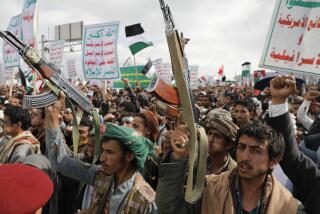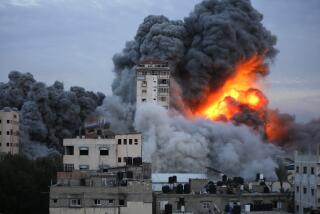Banned Missile Might Well Be Used in a War
- Share via
WASHINGTON — The Al-Samoud 2 missiles that weapons inspectors have ordered Iraq to destroy would probably be among the first weapons fired by Saddam Hussein to slow or stop a U.S. invasion, military experts say.
The missile, which is at the heart of a standoff this week between Iraq and the United Nations, could hit Kuwait City or other nearby targets with chemical or biological warheads, experts say.
The Al-Samouds are the only short-range missiles that Iraq has tested extensively and deployed in significant quantities, with perhaps 50 to 100 positioned around the country. They also constitute one of the few systems Iraq has that would be capable of striking rear U.S. and allied positions in the event of an invasion, raising the possibility that soldiers beyond the immediate field of battle could face chemical strikes by Hussein.
“I think the Al-Samoud is one of the keys to his strategy,” said John Pike, an analyst at GlobalSecurity.org. “As soon as the Iraqis decide that the U.S. 5th Corps is heading toward Baghdad, the bulk of the Al-Samouds are going to come flying out of Basra into Kuwait, tipped with an assortment of nasties.”
Analysts say the strategic importance of the missiles helps to explain why Iraq has so far refused to destroy them, even though refusal could lead to war.
Hussein signaled Monday that he would not meet U.N. demands to eliminate the weapons, saying in an interview with CBS News that he does not believe the missiles’ range exceeds the 93-mile limit imposed at the end of the 1991 Persian Gulf War.
Chief U.N. weapons inspector Hans Blix has said the Al-Samouds exceed that range limit by as much as 26 miles and has given Iraq a deadline of Saturday to begin destroying them.
The Al-Samoud is part of a system antiquated by Western standards. Jury-rigged out of Soviet-built SA-2 surface-to-air and Scud missile components, it is wildly inaccurate and capable of reaching only the closest of Iraq’s neighbors. Missiles positioned near the border with Kuwait could reach much of that country, but they could not reach Israel, for example.
U.S. intelligence officials say it’s not clear that the Al-Samoud, which translates as “steadfastness” or “endurance,” has ever been tipped with weapons of mass destruction. But military experts say there would seem to be little other purpose for it.
“A missile with this type of accuracy has virtually no ability to strike targets using conventional weapons,” said Anthony Cordesman of the Center for Strategic and International Studies, a Washington think tank. “That means it only has military meaning if it carries chemical and biological weapons Iraq has denied it possesses.”
Military experts say it is possible that Iraq has deployed Al-Samoud launchers around mosques, schools and other facilities in Basra and other cities, which would make it difficult for the U.S. to strike the launchers without inflicting civilian casualties.
Experts also say U.S. antimissile defenses could be overwhelmed by a volley of incoming Al-Samouds.
“I don’t know how many [antimissile] Patriot batteries the United States currently has in Kuwait,” Pike said. “But it’s possible [Hussein] can fire these Samouds faster than we could shoot them down.”
Iraq is thought to have other missiles capable of carrying biological or chemical payloads, including a small number of Scuds, which were banned after the Gulf War. It also is developing a more advanced short-range missile, the Al-Fatah. But experts say it does not appear to have tested that system and might have only a few of those missiles because they are complicated to assemble.
A U.N. official said Monday that the distance selected by the United Nations as the limit for the range of Baghdad’s missiles -- 93 miles -- might have been chosen simply because it is about half the effective range of a Scud.
Blix said last week that U.N. inspectors had used four different computer simulations to calculate the range of the Al-Samoud. He said all the tests concluded that the missile exceeds the range limit by significant margins.
More to Read
Sign up for Essential California
The most important California stories and recommendations in your inbox every morning.
You may occasionally receive promotional content from the Los Angeles Times.













